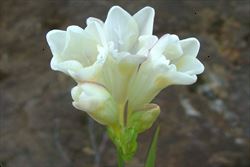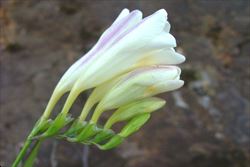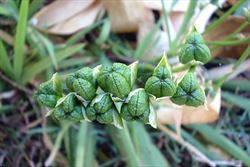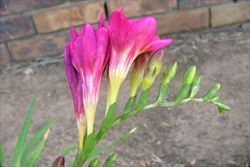Click on images to enlarge

infestation (Photo: Sheldon Navie)

habit (Photo: Sheldon Navie)

habit growing in a lawn (Photo: Sheldon Navie)

flower cluster (Photo: Sheldon Navie)

tubular flowers from side-on (Photo: Sheldon Navie)

flowers showing six style branches and yellowish throats (Photo: Sheldon Navie)

immature fruit (Photo: Sheldon Navie)

flowers of modern hybrid cultivar (Photo: Sheldon Navie)

close-up of modern hybrid cultivar flower (Photo: Sheldon Navie)
Scientific Name
Freesia alba (G.L. Mey.) Gumbl. x Freesia leichtlinii Klatt
Synonyms
Freesia leichtlinii Klatt (misapplied)
Freesia leichtlinii Klatt x Freesia refracta Klatt sensu
Freesia refracta (Jacq.) Klatt (misapplied)
Freesia refracta Klatt (misapplied)
Freesia refracta Klatt var. odorata (Klatt) Baker (misapplied)
Freesia x hybrida L.H. Bailey
Freesia cultivar
Freesia hybrid sensu D.A. Cooke
Gladiolus refractus Jacq. (misapplied)
Family
Iridaceae
Common Names
common freesia, freesia, freesia hybrid, wild freesia
Origin
A hybrid of horticultural origin whose parents (i.e. Freesia alba and Freesia leichtlinii ) are both native to southern Africa.
Cultivation
The widely naturalised freesia (i.e. Freesia alba x Freesia leichtlinii) has been commonly cultivated as a garden plant (i.e. ornamental), particularly in southern Australia.
Modern hybrid freesias, which are a complex of several different species (mainly Freesia alba, Freesia leichtlinii, Freesia corymbosa and Freesia refracta), are now much more common in cultivation. They usually have larger flowers, are less fragrant, and are available in a wide range of bright colours (e.g. golden yellow, pure white, pink, red, purple, etc.).
Naturalised Distribution
Widely naturalised in southern and eastern Australia, particularly in temperate regions. It is most common in Victoria, Tasmania, parts of south-eastern and southern South Australia and in south-western and southern Western Australia. Also naturalised in south-eastern Queensland and the coastal districts of central and northern New South Wales.
Habitat
A weed of grasslands, pastures, open woodlands, urban bushland, roadsides, waste areas, disturbed sites, footpaths, gardens and lawns in temperate and occasionally also sub-tropical regions.
Habit
A small herbaceous plant growing 10-40 cm tall. This species has long-lived (i.e. perennial) underground 'bulbs' (i.e. corms) and short-lived (i.e. annual) aboveground vegetation. It is usually dormant during summer.
Distinguishing Features
- a small plant (10-40 cm tall) growing each year from underground 'bulbs'.
- its strap-like elongated leaves (8-30 cm long and 5-10 mm wide) are mostly clustered together at the base of the plant.
- its slender flowering stems are upright, but bent horizontally just below the flowers.
-
its sweetly-scented tubular flowers (3-5.5 cm long) are white or cream in colour with purplish and yellow markings.
-
these flowers have six 'petals' with rounded tips that are partially fused together.
-
its small capsules (1-1.5 cm long) are green with a rough or wrinkled surface texture.
Stems and Leaves
The flowering stems (i.e. scapes) are usually unbranched and their bases are covered by the leaf sheaths. These stems are relatively slender, hairless (i.e. glabrous), and green in colour. They are upright (i.e. erect), but bent horizontally just below the flowers.
The strap-like leaves are elongated (i.e. lanceolate) or sword-shaped (i.e. ensiform) and are mostly clustered together at the base of the plant. These leaves (8-30 cm long and 5-10 mm wide) are rather soft-textured and pale-green in colour. They have entire margins, a prominent mid-vein, and pointed tips (i.e. acute apices). There are usually only 4-8 of these leaves on each plant and they are borne in an upright (i.e. erect) position.
Flowers and Fruit
The stalkless (i.e. sessile) flowers are borne in short spikes at the tips of the flowering stems. Three to nine of these flowers are present in each spike and they are borne in an upright (i.e. erect) position. There is a pair of small leafy bracts below each flower. The sweetly-scented flowers (3-5.5 cm long) are tubular in shape and white or cream in colour. They consist of six 'petals' (i.e. perianth segments or tepals) that are fused together for most of their length (i.e. into a corolla tube). These flowers are often purple-tinged on the outside and marked with golden-yellow on the inside of the three lower 'petal' lobes (i.e. corolla lobes). The flower tube (2-3.5 cm long) is very narrow in the lower part (i.e. the basal 6-10 mm) and the 'petal' lobes (10-20 mm long and 6-15 mm wide) have rounded tips (i.e. obtuse apices). Each flower also has three stamens, with anthers about 6 mm long, and an ovary (about 4 mm long) topped with a long style. The slender style divides into six branches near its tip, each topped with a tiny stigma. Flowering occurs during late winter and spring (i.e. from August to October).
The small capsules (1-1.5 cm long) are green in colour and have a rough or wrinkled (i.e. rugose) surface texture. The brown to black seeds (3-4 mm across) are rounded in shape and smooth in texture.
Reproduction and Dispersal
Freesia (Freesia alba x Freesia leichtlinii) produces viable seed. It also reproduces vegetatively by 'bulbs' (i.e. corms) and bulbils. The underground 'bulbs' (i.e. corms) are about 15 mm across and are relatively short-lived. They are egg-shaped (i.e ovoid) and covered with a tunic of netted fibres. The inconspicuous bulbils are produced in the lower leaf forks (i.e. axils).
The corms, bulbils and seeds are spread by road maintenance vehicles, in contaminated soil, and in dumped garden waste. Seeds and bulbils may also be spread by water and in mud.
Environmental Impact
Freesia (Freesia alba x Freesia leichtlinii) is a significant environmental weed in South Australia and Western Australia and an environmental weed in Victoria, New South Wales and Tasmania. This species can form dense infestations that compete with native vegetation, particularly native ground orchids and grasses. Densities of up to 1500 'bulbs' (i.e. corms) per square metre have been recorded in invaded bushland areas.
Freesia (Freesia alba x Freesia leichtlinii) is probably of most concern in Western Australia, where it is ranked as a high priority species in the state's environmental weed strategy. It is a serious weed of coastal heath, open woodlands and granite rock vegetation from Gingin to Israelite Bay in the south-western parts of Western Australia. For example, it is seen as the worst invasive species in Yilliminning Rock Reserve in Western Australia's wheatbelt region. Freesia (Freesia alba x Freesia leichtlinii) was first recorded in this reserve in 1992, but by 1997 it had spread throughout the crevice and meadow vegetation around Yilliminning Rock. It is now altering the structure and composition of plant communities at this location and is threatening populations of the rare native granite pimelea (Pimelea graniticola). The rapid and overwhelming invasion of freesia (Freesia alba x Freesia leichtlinii) at this site may also have a detrimental effect on the recruitment and survival patterns of this and other native species growing in these granite rock crevice and meadow communities.
This garden escape is also displacing indigenous vegetation in Victoria, as well as invading roadsides and conservation reserves (e.g. in the Brisbane Ranges National Park and Phillip Island Nature Park). It is prominent on local and regional environmental weed lists (e.g. in Moyne Shire, Knox City, Surf Coast Shire, Mitchell Shire, the Kananook Creek area, the Geelong Region, the Bendigo region and the Goulburn Broken catchment) and threatening the survival of rare native species (i.e. the critically endangered McIvor Spider-orchid, Caladenia audasii) in this state.
In South Australia, freesia (Freesia alba x Freesia leichtlinii) is locally established in native vegetation (e.g. in mallee woodlands near the former settlement of Inneston) and is a common environmental weed of the Adelaide region. It has also invaded numerous conservation areas in this state (e.g. Onkaparinga River National Park, Angove Conservation Park, Mark Oliphant Conservation Park and Sturt Gorge Recreation Park).
Legislation
Not declared or considered noxious by any state government authorities.
Management
For information on the management of this species see the following resources:
- the Environmental Weeds Action Network (EWAN) brochure on this species, which is available online at http://members.iinet.net.au/~ewan/pdf/Freesias.pdf.
- Muyt (2001), Bush Invaders of South-east Australia, pp. 90-91.
Similar Species
Freesia (Freesia alba x Freesia leichtlinii) is very similar to some other invasive bulbous species with whitish flowers, including sparaxis (Sparaxis bulbifera), lined tritonia (Tritonia gladiolaris) and hesperantha (Hesperantha falcata). These species can be distinguished by the following differences:
- freesia (Freesia alba x Freesia leichtlinii) flowers are white or cream, often with some purplish markings on the outside, and the lower three 'petals have yellow markings on the inside. The flower styles are divided into six branches and hence they have six stigmas.
- sparaxis (Sparaxis bulbifera) flowers are white or cream, often with some purplish markings on the outside, and their centres are usually yellow. The flower styles are divided into three branches and hence they have three stigmas.
- lined tritonia (Tritonia gladiolaris) flowers are white or cream, but covered with a network of thin dark brown lines. The flower styles are divided into three branches and hence they have three stigmas.
- hesperantha (Hesperantha falcata) flowers are white or cream with a distinctive purple-brown colour on the outside of the 'petals'. The flower styles are divided into three branches and hence they have three stigmas.

